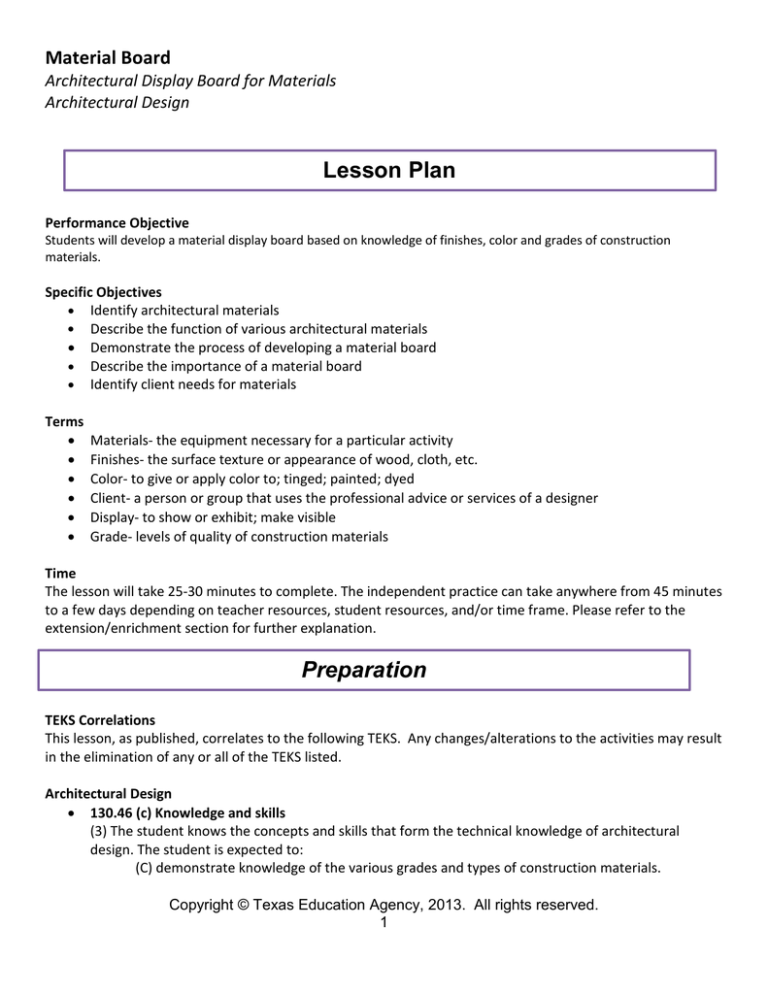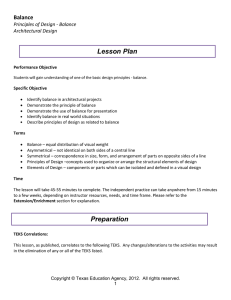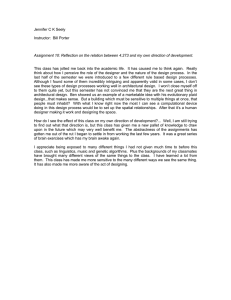Lesson Plan Material Board Architectural Display Board for Materials Architectural Design
advertisement

Material Board Architectural Display Board for Materials Architectural Design Lesson Plan Performance Objective Students will develop a material display board based on knowledge of finishes, color and grades of construction materials. Specific Objectives • Identify architectural materials • Describe the function of various architectural materials • Demonstrate the process of developing a material board • Describe the importance of a material board • Identify client needs for materials Terms • • • • • • Materials- the equipment necessary for a particular activity Finishes- the surface texture or appearance of wood, cloth, etc. Color- to give or apply color to; tinged; painted; dyed Client- a person or group that uses the professional advice or services of a designer Display- to show or exhibit; make visible Grade- levels of quality of construction materials Time The lesson will take 25-30 minutes to complete. The independent practice can take anywhere from 45 minutes to a few days depending on teacher resources, student resources, and/or time frame. Please refer to the extension/enrichment section for further explanation. Preparation TEKS Correlations This lesson, as published, correlates to the following TEKS. Any changes/alterations to the activities may result in the elimination of any or all of the TEKS listed. Architectural Design • 130.46 (c) Knowledge and skills (3) The student knows the concepts and skills that form the technical knowledge of architectural design. The student is expected to: (C) demonstrate knowledge of the various grades and types of construction materials. Copyright © Texas Education Agency, 2013. All rights reserved. 1 Interdisciplinary Correlations Chemistry • 112.35 (c) Knowledge and skills (3) Scientific processes. The student uses critical thinking, scientific reasoning, and problem solving to make informed decisions within and outside the classroom. The student is expected to: (A) in all fields of science, analyze, evaluate, and critique scientific explanations by using empirical evidence, logical reasoning, and experimental and observational testing, including examining all sides of scientific evidence of those scientific explanations, so as to encourage critical thinking by the student; and (B) communicate and apply scientific information extracted from various sources such as current events, news reports, published journal articles, and marketing materials. English • 110.31 (c) Knowledge and skills (15) Writing/Expository and Procedural Texts. Students write expository and procedural or workrelated texts to communicate ideas and information to specific audiences for specific purposes. Students are expected to: (D) produce a multimedia presentation (e.g., documentary, class newspaper, docudrama, infomercial, visual or textual parodies, theatrical production) with graphics, images, and sound that conveys a distinctive point of view and appeals to a specific audience. Occupational Correlation (O*Net – www.onetonline.org) Job Title: Architects, Except Landscape and Naval O*Net Number: 17-1011.00 Reported Job Titles: Architectural Project Manager, Principal, Design Architect Tasks • • • • Consult with clients to determine functional or spatial requirements of structures. Prepare scale drawings. Plan layout of project. Prepare information regarding design, structure specifications, materials, color, equipment, estimated costs, or construction time. Soft Skills: Active Listening, Complex Problem Solving, Critical Thinking Accommodations for Learning Differences It is important that lessons accommodate the needs of every learner. These lessons may be modified to accommodate students with learning differences by referring to the files found on the Special Populations page of this website (cte.unt.edu). Preparation • Review and familiarize yourself with the presentation. Copyright © Texas Education Agency, 2013. All rights reserved. 2 • • • Find samples or create a sample material display board. Pre-order materials for students. If students need to order materials, this will take much longer to complete the final project. Prepare for this lesson to take 25-30 minutes. The Extension/Enrichment section of this lesson contains some ideas that can extend the lesson. The extent of the time frame given can vary depending on your needs and resources. References • Kicklighter, C. E. (2000). Architecture: Residential drawing and design. South Holland, IL: GoodheartWllcox. Instructional Aids • Lesson Presentation • Reference Books (if available) • Instructor Computer/Projection Unit Materials Needed • Design magazines/books (architectural, interior design, construction, etc.) • Paper (colored, card stock, construction, etc.) • Display boards (crescent, foam core, etc.) • Writing utensils (pens, pencils, colored pencils, markers, etc.) Equipment Needed • Measuring tapes (if needed) • Architectural scales (if needed) • Cutting tools (scissors, blades, etc.) • Adhesive (glue, tacky, tape, etc.) • Straight edges Learner Preparation Discuss safety rules for use of equipment and materials. Introduction The main purpose of this lesson is to help students: • Learn about important materials (past) • Understand how to properly present materials for consideration (present) • Plan for future presentations, which includes choosing materials (future) • Show examples of material display boards. Allow students to ask questions and discuss pictures if they are unclear or curious. If you have a sample, use it in the presentation and discuss with students. • Ask students if they have ever had to help someone pick paint colors or materials for a project. Copyright © Texas Education Agency, 2013. All rights reserved. 3 • Tell students that there are many factors that determine how and why to pick certain materials, colors, and finishes for a project. A designer should be familiar with this process and how people will react to their choices. • Ask students if they have ever made a choice they were sure about, but then resulted in an unexpected outcome. • Tell students that people will try and guess at selecting items for a home—sometimes very costly items—and it can turn out unfavorable. Most people do not have the “vision” to select items or colors. As a designer, you have ideas and visions of what projects may look like before they are constructed or finished. • Ask students if they have ever been to their local home improvement store and seen samples of materials or paint. • Tell students that these samples are for people to develop ideas of what the finished product may look like. Designers can use these samples to create a display board of colors, materials, finishes, and samples that can be used for the project and to help people make informed decisions. These items help give a better understanding of the whole picture. Outline Outline (LSI Quadrant II) Instructors can use the software presentation and slides in conjunction with the following outline. OUTLINE MI I. Prior knowledge of materials. II. Begin discussion over people’s prior knowledge of materials and their expectations. III. Introduce equipment, supplies, and materials for display board. NOTES TO INSTRUCTOR Begin discussion over materials. Discover students’ prior knowledge. Use images from websites, books, slide show, etc. Begin discussion over the designer’s role and how it relates to the client. Discover students’ prior knowledge. Demonstrate how to use supplies and equipment to build the display boards. Copyright © Texas Education Agency, 2013. All rights reserved. 4 IV. V. Show students how to order or obtain samples. Independent Practice Model asking questions to obtain samples. Demonstrate how to order samples from magazines or from web-based sources. Students will develop their own material display boards. Multiple Intelligences Guide Existentialist Interpersonal Intrapersonal Kinesthetic/ Bodily Logical/ Mathematical Musical/Rhythmic Naturalist Verbal/Linguistic Application Guided Practice (LSI Quadrant III) 1. Model how to order products 2. Discuss how to approach home improvement stores for samples. 3. Model how to develop board 4. Discuss and show how to select items Independent Practice (LSI Quadrant III) 1. Students will use existing materials to develop material display board 2. Students will order new sample materials for use on the material display board Summary Review (LSI Quadrants I and IV) • Check students understanding of project Evaluation Informal Assessment (LSI Quadrant III) Any and all of the following can be used as informal assessments: • Spot check for understanding • Spot check for craftsmanship Copyright © Texas Education Agency, 2013. All rights reserved. 5 Visual/Spatial • Spot check for material and color usage Formal Assessment (LSI Quadrant III, IV) • Completed material display board Enrichment Extension/Enrichment (LSI Quadrant IV) • Students can use their own materials to enhance the display board • Students can use alternate methods to enhance the display board • Students can work in pairs or groups to develop the display board Copyright © Texas Education Agency, 2013. All rights reserved. 6 Architectural Material Board Architectural Display Board for Materials Handout Concepts • Material Board A material board is a display board that shows various materials, finishes, colors, etc. that can be used for a particular project. • Board A board is a piece of material that is used to display items. • Materials Materials can range from items used to build something to equipment needed for a particular project. • Color Board A color board is a display board that shows a study of colors for a particular project. Vocabulary • Materials- the equipment necessary for a particular activity • Finishes- the surface texture or appearance of wood, cloth, etc. • Color- to give or apply color to; tinged; painted; dyed • Client- a person or group that uses the professional advice or services of a designer • Display- to show or exhibit; make visible • Grade- levels of quality of construction materials Copyright © Texas Education Agency, 2013. All rights reserved. 7 Architectural Material Board Project Architectural Material Board Students will develop a material display board based on knowledge of finishes, color and grades of construction materials. Option A Students will develop a material board for one room of a house. Option B Students will develop a material board for one room of a house that includes two options for the client to choose from based on grade and finishes. The options should be different in price range. Option C Student will develop a material board for an entire house that coordinates in colors, finishes and grades. Teacher • • • Teacher will determine final criteria and layout of the material display board. These will be determined by the teacher’s available resources for the class and the allotted time for the project. Several options are given above. Teacher should determine the minimum criteria needed for the material display board. The following is sample criteria: o Paint colors for bedrooms, bathrooms, and living areas o Materials for bath and kitchen cabinets (can be the same or different for each area) o Materials for bath and kitchen countertops (can be the same or different for each area) o Lighting samples (pictures) o Flooring samples (carpet, tile, etc.) o Finishes for wall and ceilings Teacher can enhance the given criteria with equipment selection, fixtures, appliances, etc. Teacher can allow for more in-depth research by giving fewer criteria but requiring deeper investigation. Student • • • Student will develop a material board for a fictional room. Student will use a “board” material as the base of the display. Student will use color swatches, material samples, finish samples, etc. on the display board to embellish the overall design. Presentation This project can be used as the presentation material for the Presentation Lesson Plan. Copyright © Texas Education Agency, 2013. All rights reserved. 8 Rubric Template Task Statement: Architectural Material Board Task Assignment: Architectural Display Board for Materials Criteria Concepts/Skills to be Assessed Materials Novice 1 Criteria Categories (Novice to Exemplary) Developing 2 Exemplary 4 No evidence of materials Some evidence of materials Satisfactory evidence of materials Materials used in effective way No evidence of finishes Some evidence of finishes Satisfactory evidence of finishes Finishes used and properly displayed No evidence of color selections Some evidence of color selections Satisfactory evidence of color selections Colors were properly used and displayed Very poor craftsmanship of board Poor craftsmanship of board Good craftsmanship of board Excellent craftsmanship of board Did not complete the board Completed some of the board Completed most of the board Completed all of the board (Possible 4 points) Finishes (or equipment) Accomplished 3 (Possible 4 points) Colors (Possible 4 points) Craftsmanship (Possible 4 points) Completion (Possible 4 points) A = 20 – 17 points Total Points: 20 B = 16 – 13 points C = 12 – 9 points D = 8 – 5 points F = 4 – 1 points Copyright © Texas Education Agency, 2013. All rights reserved. 9 Points Earned


